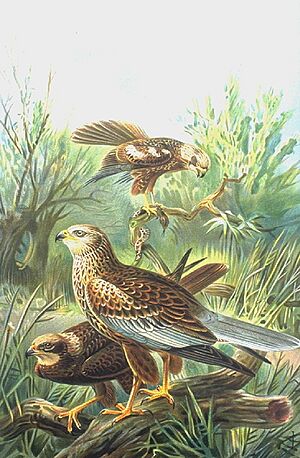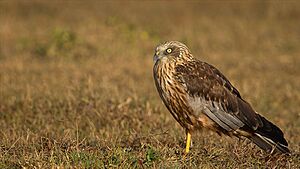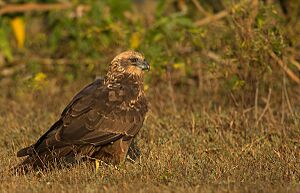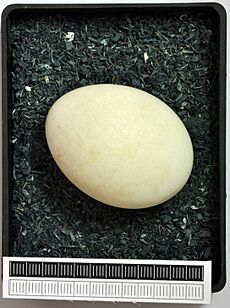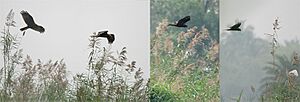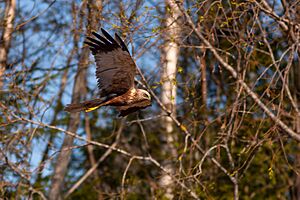Western marsh harrier facts for kids
Quick facts for kids Western marsh harrier |
|
|---|---|
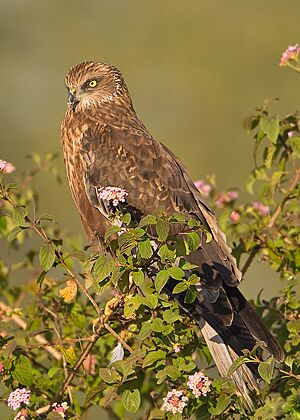 |
|
| Male | |
| Conservation status | |
| Scientific classification | |
| Genus: |
Circus
|
| Species: |
aeruginosus
|
| Subspecies | |
|
|
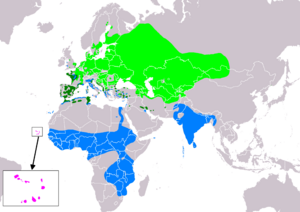 |
|
| Range of C. aeruginosus Breeding Resident Non-breeding Vagrant (seasonality uncertain) | |
| Synonyms | |
|
Falco aeruginosus Linnaeus, 1758 |
|
The western marsh harrier (Circus aeruginosus) is a large harrier. It is a type of bird of prey that lives in Europe, Asia, and parts of Africa. People also call it the Eurasian marsh harrier.
This bird used to be grouped with other similar harriers. But now, scientists consider those other birds to be separate species. These include the eastern marsh harrier and the swamp harrier.
There are two main types, or subspecies, of the western marsh harrier. One type, C. a. aeruginosus, travels long distances. The other, C. a. harterti, stays in northwest Africa all year.
Contents
About the Western Marsh Harrier
Naming the Bird
The famous Swedish scientist Carl Linnaeus first officially described the western marsh harrier. He did this in 1758 in his book Systema Naturae. He gave it the scientific name Falco aeruginosus.
Later, the bird was placed in the genus Circus. This name comes from an old Greek word, kirkos. It means "circle" and refers to how these birds fly in circles. The word aeruginosus is Latin for "rusty," which describes its color.
Different Types of Western Marsh Harriers
Scientists recognize two subspecies:
- C. a. aeruginosus: This type breeds in Europe, the Middle East, and Central Asia. It spends winters in southern Europe, Africa, and South Asia.
- C. a. harterti: This type lives all year in northwest Africa.
What Does the Western Marsh Harrier Look Like?
The western marsh harrier is a big bird. It is about 48 to 56 centimeters (19 to 22 inches) long. Its wings can spread up to 115 to 130 centimeters (45 to 51 inches) wide. Males weigh about 400 to 650 grams (0.9 to 1.4 pounds). Females are heavier, weighing 550 to 800 grams (1.2 to 1.8 pounds).
Males and females look different. This is called sexual dimorphism.
Male Harriers
The male bird is mostly a reddish-brown color. It has lighter yellowish stripes, especially on its chest. Its head and shoulders are pale grayish-yellow. The tail feathers and some wing feathers are pure gray. These gray parts stand out against the brown front part of the wing and the black wingtips.
When a male flies, you can see three colors: brown, gray, and black. Its legs, feet, and eyes are yellow.
Female Harriers
The female is almost completely chocolate-brown. The top of her head, throat, and shoulders are a lighter yellowish color. This light color can be very clear or more faded. The area around her eyes is darker, making her light-colored eyes stand out. Females do not have the gray wing patch or tail that males have.
Young Harriers
Young birds look similar to females. However, they usually have less yellow on their bodies, especially on their shoulders.
There is also a rare dark-colored type of this bird. It looks mostly black when it flies. This dark type is more common in the eastern parts of its range.
Where Do Western Marsh Harriers Live?
These birds breed across a wide area. This includes Europe, northwest Africa, Central Asia, and parts of the Middle East. They breed in most European countries. However, they are not found in mountains or very cold northern areas.
Most western marsh harriers move to different places during the year. Some spend winter in warmer parts of southern Europe. Others fly to Africa, Arabia, or India. The type that lives in northwest Africa, harterti, stays there all year.
Sometimes, these birds fly far off course. They have been seen in places like Iceland and the Caribbean.
Harrier Homes
Western marsh harriers love wetland areas. They especially like places with lots of common reed plants. They can also live in other open areas like farmland and grassland. These areas are often next to marshlands.
During breeding season, they protect their own space. Even in winter, they seem to be less social than other harriers. This might be because they prefer specific habitats. In some places, many western marsh harriers gather to rest together. They often choose tall grass or floating plants to sleep in. This helps them notice if predators are trying to sneak up on them.
How Western Marsh Harriers Live
Reproduction and Life Cycle
The breeding season starts between mid-March and early May. Male western marsh harriers often have two or three female partners. A pair usually stays together for one breeding season. However, some pairs might stay together for several years.
The nest is built on the ground. It is made from sticks, reeds, and grasses. Nests are usually found in a reedbed. But sometimes, they build nests in farm fields. A female usually lays between three and eight eggs. The eggs are white and oval-shaped. They might look bluish or greenish when they are first laid.
The eggs are kept warm for 31 to 38 days. This is called incubation. The young birds are ready to fly after 30 to 40 days.
Food and Hunting
The western marsh harrier hunts in a special way. It glides low over open ground. Its wings are held in a shallow V-shape. It often lets its legs hang down as it searches for food.
It eats small mammals, small birds, insects, reptiles, and frogs.
Protecting the Western Marsh Harrier
The number of western marsh harriers went down in many areas. This happened between the 1800s and the late 1900s. People hunted them, destroyed their homes, and used too many pesticides.
Now, this bird is a protected species in many countries. In Great Britain, they almost disappeared completely. But thanks to protection efforts, their numbers are growing again. They have also made a comeback in Ireland.
The western marsh harrier still faces some dangers. Birds are sometimes shot when they fly through the Mediterranean region. They can also be bothered during breeding season. Lead from old hunting bullets can also poison them.
However, most of the big threats to this bird have been stopped. Today, the IUCN lists it as a species of "Least Concern". This means it is not in danger of disappearing.
Images for kids




